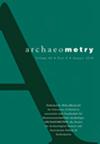揭开历史的阴影:波兰什平高斯基森林和死亡谷第二次世界大战暴行的化学痕迹
IF 1.5
3区 地球科学
0 ARCHAEOLOGY
引用次数: 0
摘要
本文介绍了从波兰什平高斯基森林和死亡谷挖掘出的第二次世界大战万人坑中采集的 17 个样本中有机物化学成分的分析结果以及特征地球化学和生物化学标记的出现情况。研究结果表明,通过焚烧受害者尸体来掩盖大规模罪行的企图留下了自己的痕迹--每一次掩盖罪行的企图都与制造更多的犯罪证据有关。本文章由计算机程序翻译,如有差异,请以英文原文为准。

Unearthing the shadows of history: Chemical traces of Second World War atrocities in the Szpęgawski Forest and Death Valley, Poland
This article presents the results of analyses of the chemical composition of organic matter and the occurrence of characteristic geochemical and biochemical markers in 17 samples collected from the Second World War mass graves excavated in the Szpęgawski Forest and Death Valley, Poland. The results show that attempts to cover up mass crimes by burning the bodies of the victims have left their own traces—that each attempt to cover up the crime is associated with the creation of further evidence of the crimes committed.
求助全文
通过发布文献求助,成功后即可免费获取论文全文。
去求助
来源期刊

Archaeometry
地学-地球科学综合
CiteScore
3.60
自引率
12.50%
发文量
105
审稿时长
6 months
期刊介绍:
Archaeometry is an international research journal covering the application of the physical and biological sciences to archaeology, anthropology and art history. Topics covered include dating methods, artifact studies, mathematical methods, remote sensing techniques, conservation science, environmental reconstruction, biological anthropology and archaeological theory. Papers are expected to have a clear archaeological, anthropological or art historical context, be of the highest scientific standards, and to present data of international relevance.
The journal is published on behalf of the Research Laboratory for Archaeology and the History of Art, Oxford University, in association with Gesellschaft für Naturwissenschaftliche Archäologie, ARCHAEOMETRIE, the Society for Archaeological Sciences (SAS), and Associazione Italian di Archeometria.
 求助内容:
求助内容: 应助结果提醒方式:
应助结果提醒方式:


